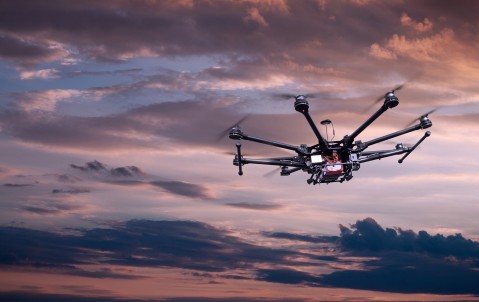
Send in the drones
As the commercial drone market takes off, insurers could reap the rewards.
After Hurricane Irma hit the US, the Federal Aviation Authority (FAA) issued 132 airspace authorisations to allow drones to fly in the affected areas of Florida. Drone use ranged from the Air National Guard assessing and prioritising which areas of the hurricane-devastated state needed help, to utility companies like the Jacksonville Electric Authority checking its power lines as it fought to restore power. Drone operator Airbus Aerial also provided data to insurers to help assess homeowners’ insurance claims.
Responding to a major catastrophe like Irma is another illustration of the growing mainstream adoption of drones and further serves to highlight the need for the insurance sector to respond with tailored drone products, rather than trying to adapt existing and ill-fitting aviation covers.
Drone expansion
Drones or unmanned aerial vehicles (UAVs) are no longer simply a plaything for park and playground amusement. They have become serious pieces of technologically-enabled kit with a varied role to play in many businesses’ day-to-day operations. As proof of their growing popularity, nearly 60,000 remote pilot certificates – required by commercial operators to fly drones – have been issued in the US since the Federal Aviation Administration (FAA) introduced the licensing requirement in 2016.
"We see a lot of our US clients using drones across a wide range of sectors. Our rail clients do their bridge inspections using drones, which are quicker and cheaper as well as being far safer than sending out people."
It’s a fast rising trend of drone use that Hiscox’s Ed Wallis, Liability Underwriter, says is reflected in the clients he deals with. "We see a lot of our US clients using drones across a wide range of sectors from construction, to rail and energy businesses. Our rail clients do their bridge inspections using drones, which are quicker and cheaper as well as being far safer than sending out people. They also use developing drone technology to look at the state of the track.”
As well as a risk mitigation tool, drones also have a key role to play after a loss has occurred. “If there has been a derailment involving crude oil or other dangerous substances, for example, rather than sending in people in hazmat suits, they can just send in a drone and get far closer,” says Wallis.
The growth picture for drones in the UK and Europe is similar to that in the US, says Simon Ritterband, CEO of Moonrock, a specialist drone insurer offering cover underwritten by Hiscox. “The rise in drone use is astronomical, particularly in areas like construction, mapping, surveying and agriculture.”
Part of this is down to the increasing sophistication of the drones and their payload, adds Ritterband. “It is now possible to use drones with Light Detection and Ranging (LIDAR) systems, for example, which can provide highly detailed three-dimensional images of the ground. Functionality like this is hugely valuable to surveyors and architects and is one of the reasons why companies are training and employing their own drone pilots.”
Crowded airspace
Despite the advantages there are a number of potential risks that commercial drone operators face, ranging from third party liability and property damage, to damage to the drone itself, as well as other potential risks, such as infringement of privacy. News reports regularly carry stories of commercial aircraft nearly missing drones flying around airports, while earlier this year, a Boeing 737-700 jet sustained nosecone damage from a drone as it came in to land at Mozambique airport. And in February 2017, the owner of an aerial photography business received a 30-day jail sentence and a $500 fine after being found guilty by a Seattle court of ‘reckless endangerment’ after a drone he was operating in 2015 crashed into a crowd and knocked a woman unconscious.
While leisure use of drones is broadly unregulated, commercial drone pilots in the US must satisfy a number of requirements.
Although the FAA recorded nearly 600 incidents of drones flying too close to airplanes and/or airports in the six months to January 2016, most incidents are more likely to be caused by leisure users as opposed to commercial drone pilots. While leisure use of drones is broadly unregulated, commercial drone pilots in the US must satisfy a number of requirements such as having a Remote Pilot Airman Certificate and submit to vetting by the Transport Security Administration.
Meeting these requirements is a prerequisite for insurance cover says Wallis. “We have started providing contingent cover under our general liability programmes for US clients where we insist that the drone is operated by an approved commercial drone pilot, has to be under 25kg and be administered under FAA guidelines.”
The UK’s regulatory framework involves an obligation to register with the CAA as well as purchasing compulsory public liability cover. This appears to be keeping commercial incidents low. Ritterband confirms that, amongst the 1600 commercial operators it insures, Moonrock has so far only seen one public liability claim, which was for a drone knocking off a roof tile.
Take cover
The insurance industry is then poised to take advantage of what Goldman Sachs estimates as a $100 billion dollar industry and would appear – in the commercial drone sector at least – to be an industry characterised by low losses. To successfully do that however, insurers must ensure that they address the specific risk profile of the drone industry and resist the temptation to simply adapt standard aviation policies to cover drone operations.
Many of these standard policies fail to take into account the unique risks posed by drones and even lack the legal cover required under some jurisdictions, says Ritterband. “An obvious deficiency,” Ritterband adds, “is that basic aviation policies do not have war and terrorism cover in compliance with the EU’s Regulation (EC) 785/2004, which has now been laid down as a requirement for drone insurance by the CAA. It's very clear that simply crossing out aircraft on an aviation policy wording and replacing with 'drone' or UAV is no answer."
Insurers must ensure that they address the specific risk profile of the drone industry and resist the temptation to simply adapt standard aviation policies to cover drone operations.
Under the sea
Given the growing use of drones, insurance cover is likely to become a regular part of many businesses’ overall insurance programmes, putting the onus on the insurance market to respond and provide specially-developed products. The firms that get it right could reap opportunities that go well beyond aerial drones, says Ritterband. "The use of underwater marine drones for commercial purposes such as by fishermen looking for fish or by shipping companies carrying out hull inspections is likely to be the next big growth area for drone development.”



